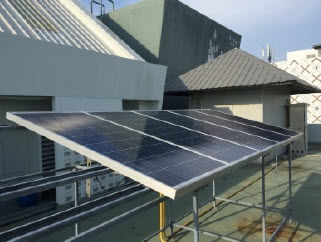Load Profiles in Grid-Connected Residential Buildings: Experimental Studies with Rooftop PV and Battery Systems
Keywords:
Load profile, Residential building, Rooftop PV, Battery systemAbstract
The number of photovoltaic (PV) installation in many countries has increased in the past decades. The advantages of energy from PV consists of reduction of CO2 emission, low maintenance cost, low operation cost, etc. On the other hand, the main problems of this technology consist of: (1) electrical power is relatively fluctuated and (2) the excessive energy from PV generating cannot be stored for any use in another necessary time. One of the solving solution is the integration of the PV systems with battery systems to keep the system stability. Moreover, the reduction of battery price leads the electricity users interest in the installation of battery systems with rooftop PV on their buildings. In the past, a number of works studied on PV systems with integrated batteries as the off-grid systems and evaluated by simulation programs. In this work, the load profiles of buildings in different categories (i.e. households, small offices, and home offices) of residential section are discussed. The characteristics of load profiles in residential buildings installed with a grid-connected rooftop PV system with batteries are analyzed by physical experimentations. It was found that battery systems were significantly affected the load profiles of the residential buildings. Household was found to be the highest proportion (21.68%) of excessive electricity. The ratio of PV met to load (29.15%) was smaller than the ratio of battery charging (50.17%). In addition, the excessive electricity in small office was the lowest proportion (10.39%), while the ratio of PV met to load (57.83%) was higher than the battery charging (31.78%).
References
Beck, T., Kondziella, H., Huard, G., & Bruckner, T. (2016). Assessing the influence of the temporal resolution of electrical load and PV
generation profiles on self-consumption and sizing of PV-battery systems. Applied Energy,
, 331-342.
Department of Renewable Energy Development and Energy Efficiency. (2015). Alternative Energy Development Plan:AEDP2015. Retrieved from http://www.eppo.go.th/images/POLICY/ENG/ AEDP2015ENG.pdf
Haque, M. M., & Wolfs, P. (2016). A review of high PV penetrations in LV distribution networks: Present status, impacts and mitigation measures. Renewable and Sustainable Energy Reviews, 62, 1195-1208.
Lorenzi, G., & Silva, C. A. S. (2016). Comparing demand response and battery storage to optimize self-consumption in PV systems. Applied Energy, 180, 524-535.
Metropolitan Electricity Authority (2015). Load profile. Retrieved from http://www.mea.or.th/en/profile/109/111
Ogunjuyigbe, A. S. O., Ayodele, T. R., & Oladimeji, O. E. (2016). Management of loads in residential buildings installed with PV system under intermittent solar irradiation using mixed integer linear programming. Energy and Buildings, 130, 253-271.
Opiyo, N. (2016). Energy storage systems for PVbased communal grids. Journal of Energy Storage, 7, 1-12.
Posada, J. O. G., Rennie, A. J. R., Villar, S. P., Martins, V. L., Marinaccio, J., Barnes, A., … Hall, P. J. (2017). Aqueous batteries as grid scale energy storage solutions. Renewable and Sustainable Energy Reviews, 68, 1174-1182.
Provincial Electricity Authority. (2015). Load profile. Retrieved from http://peaoc.pea.co.th/loadprofile/
Quoilin, S., Kavvadias, K., Mercier, A., Pappone, I., & Zucker, A. (2016). Quantifying selfconsumption linked to solar home battery systems: Statistical analysis and economic assessment. Applied Energy, 182, 58-67.
Shah, R., Mithulananthan, N., Bansal, R. C., & Ramachandaramurthy, V. K. (2015). A review of key power system stability challenges for large-scale PV integration. Renewable and Sustainable Energy Reviews, 41, 1423-1436.
Shen, W. X. (2009). Optimally sizing of solar array and battery in a standalone photovoltaic system in Malaysia. Renewable Energy, 34(1),
-352.
Treado, S. (2015). The effect of electric load profiles on the performance of off-grid residential hybrid renewable energy systems. Energies, 8(10), 11120-11138.
Watson, J. D., Watson, N. R., Santos-Martin, D., Wood, A. R., Lemon, S., & Miller, A. J. V. (2016). Impact of solar photovoltaics on the low-voltage distribution network in New Zealand. IET Generation, Transmission and Distribution, 10, 1-9.













